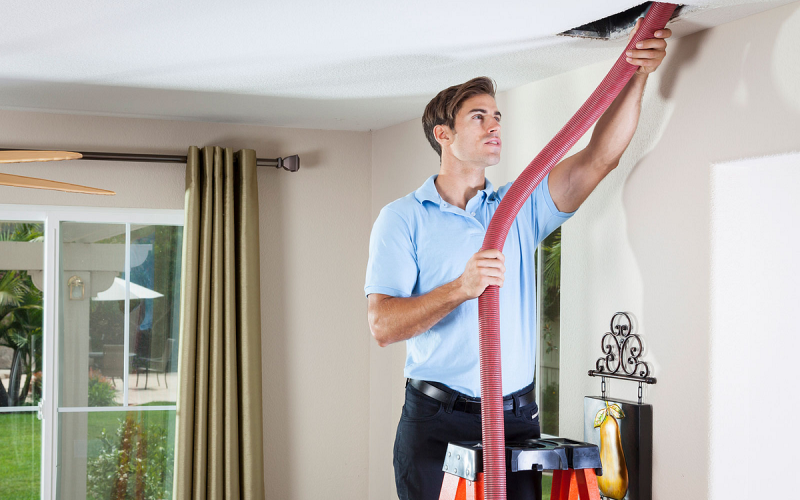Introduction
Have you ever walked into your home and noticed the air feels heavy, dusty, or even a bit musty? You clean your floors, wash your windows, and wipe down surfaces regularly—but what about the air you breathe? One hidden area in every home that often goes unnoticed is the air duct system. These ducts circulate the air that you and your family breathe daily. If they’re full of dust, mold, and allergens, that’s what ends up in your lungs.
This is where duct cleaning comes in. It may sound simple, but the impact it has on your home’s indoor air quality and your health is huge. In this guide, we’ll explore how duct cleaning works, why it matters, and the powerful secrets behind cleaner, fresher air in your living space.
What Is Duct Cleaning?
Duct cleaning is the process of removing dust, dirt, mold, pet dander, and other debris from the heating, ventilation, and air conditioning (HVAC) system in your home. These systems usually include supply and return air ducts, registers, grilles, fans, and even the furnace if it’s connected.
Over time, as your system circulates air, small particles build up inside the ducts. If left uncleaned, this buildup can clog your airflow, reduce system performance, and pollute the air in your home.
Why Does Duct Cleaning Matter for Indoor Air?
Indoor air directly affects how healthy and comfortable you feel at home. Every time your heating or cooling system runs, air flows through ductwork that may contain dust, debris, pet hair, mold spores, and allergens. If left unchecked, these particles recirculate into your living space, silently affecting your breathing environment. This is why one of the most overlooked yet critical home maintenance tasks is duct cleaning.
Why Should Clean Ducts Be a Priority?
When ducts aren’t maintained, they become a hidden source of pollution. Think about how quickly dust gathers on furniture—now imagine that same buildup inside narrow, unseen passages where air circulates daily. Dirty ducts can lower indoor air quality, strain HVAC systems, and worsen allergies. On the other hand, clean ducts ensure airflow remains fresh, balanced, and healthier for your family.
What Problems Arise from Dirty Air Ducts?
Neglected ducts bring more than just dusty surfaces. Common issues include musty odors, frequent sneezing, increased asthma triggers, and uneven heating or cooling. In extreme cases, moisture trapped inside ducts allows mold growth, which can spread throughout your home. Poor maintenance can also lead to blocked vents, clogged filters, air leaks, reduced efficiency, higher utility bills, HVAC breakdowns, and poor airflow. These problems silently grow over months or years, making routine cleaning essential.
What Are the Main Benefits of Duct Cleaning?
The advantages extend far beyond dust removal. Homeowners often notice fresher-smelling rooms, easier breathing, and reduced dusting chores after service. Clean ducts allow HVAC systems to work efficiently, lowering energy consumption. Families with pets or young children particularly benefit since improved indoor air quality, allergen reduction, mold prevention, system efficiency, longer HVAC lifespan, energy savings, odor removal, cleaner airflow, and reduced maintenance costs are all linked to regular cleaning. As HVAC expert Sarah Johnson explains, “Investing in duct cleaning isn’t just about cleanliness—it’s about protecting your health and ensuring your system doesn’t work harder than it should.”
What Role Does Air Vent Cleaning Play?
A major part of the process is air vent cleaning, which directly affects airflow. While ducts carry air, vents distribute it into rooms. Dusty vents blow contaminants straight into your breathing space. Cleaning vents alongside ducts helps achieve maximum efficiency, balanced temperature distribution, and dust control. This ensures every room benefits from clean, filtered air.
What Do Professionals Say About Duct Cleaning?

Industry specialists agree that ducts should be cleaned every 3–5 years depending on household conditions. According to HVAC consultant David Miller, “People often wait until allergies flare or their system struggles before calling a professional. Regular duct cleaning prevents those issues and creates a healthier living environment.” This professional insight underscores the importance of proactive maintenance rather than waiting for visible problems.
How Much Does Duct Cleaning Cost?
Here’s a clear breakdown of average costs:
| Service Type | Average Price Range | Notes |
|---|---|---|
| Basic Duct Cleaning | $300 – $500 | Standard home service |
| Deep Cleaning + Sanitizing | $500 – $800 | Recommended for mold or severe buildup |
| Dryer Vent Cleaning | $100 – $200 | Often offered as an add-on |
| Full HVAC Cleaning Package | $800 – $1,200 | Includes ducts, vents, coils, and blower |
What Are the Key Features of Professional Cleaning?
A professional service usually includes: negative pressure vacuuming, HEPA filtration, rotary brushing, vent disinfection, coil cleaning, blower motor cleaning, mold inspection, sanitizer application, leak detection, airflow testing, and odor removal. These features guarantee thorough results that DIY methods cannot achieve.
How Does Cleaning Improve Safety?
Clogged ducts can trap lint, hair, and dust—materials that pose a fire hazard when combined with warm airflow. Cleaning reduces this risk while ensuring mold spores and bacteria aren’t spreading through the air. Families with children, elderly members, or pets especially benefit since safety isn’t just about comfort—it’s about preventing hidden hazards.
Are Emergency Cleaning Services Available?
Yes. In cases of sudden mold outbreaks, severe allergies, post-renovation dust storms, or pest infestations, many companies offer emergency duct cleaning services. These rapid-response solutions restore clean air quickly, giving peace of mind when health risks are urgent.
Conclusion: Why Choose Duct Cleaning Today?
Clean air is not optional—it’s essential for well-being, comfort, and system efficiency. From preventing hidden mold growth to reducing allergies, duct cleaning directly protects your household. Don’t wait until symptoms appear; schedule professional cleaning to breathe cleaner, fresher, and safer air today. Call a trusted duct cleaning specialist now to protect your home, your family, and your health.
FAQS
1. How frequently should ductwork be serviced?
Most homes benefit from cleaning every 3 to 5 years, but if you notice excess dust, unpleasant smells, or worsening allergies, it’s best to schedule it sooner.
2. Can cleaning ducts help minimize allergy symptoms?
Absolutely. Removing dust mites, pet dander, and pollen from ducts can significantly reduce triggers that worsen allergy issues.
3. Will duct cleaning lower my energy expenses?
Yes. By clearing blockages and improving airflow, your HVAC system runs more efficiently, which helps cut energy costs.
4. How does duct cleaning differ from vent cleaning?
Duct cleaning addresses the entire network of air passages, while vent cleaning focuses specifically on the registers and grilles where air enters rooms.
5. Is hiring a professional better than trying to clean ducts yourself?
Definitely. Experts have advanced equipment like HEPA-filter vacuums and rotary brushes that reach deeper than DIY tools.
6. How long does a duct cleaning session usually last?
On average, it takes between 2 to 4 hours, depending on the size of your home and the complexity of your HVAC system.
Read More Chimney Sweep.












